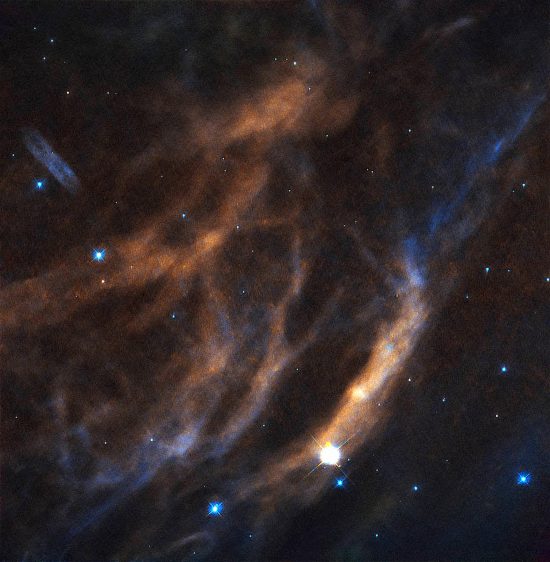
A portion of bubble nebula Sh2-308. Credit: ESA/Hubble & NASA
Apr 21, 2017
Spherical shells around stars are signs of electrical activity.
More than 70 years ago Dr. Charles Bruce noted that planetary nebulae are similar to electric discharges. He reasoned that their shapes were hourglasses, with central stars obscured by dusty toroids. Since nebular shapes are similar to the twisted filaments and spirals of electric discharges, they also appear as near-spherical shapes.
A recent press release states that a “bubble-like structure” is wrapped around Wolf-Rayet star Sh2-308, or EZ Canis Majoris in the constellation Canis Major. As the announcement says, “…ongoing radiation from the star pushes the bubble out farther and farther, blowing it bigger and bigger…some 60 light-years apart!”
Electric discharges in plasma form double layers along their current axes. Positive charges build up on one side of the cloud and negative charges on the other. A powerful electric field develops between them and if enough charge is applied the double layer glows otherwise, it remains in “dark mode” and is invisible. In plasma, the electric charges spiral into filaments, which attract each other, sometimes “pinching” into arc mode discharges.
As written many times, double layers can be “pumped” with energy from galactic Birkeland currents. Increased flux density draws matter from surrounding space into filaments, igniting nebular “gases” electrically. Could this be what is reported by the European Space Agency? Unfortunately, at this point in time, the only way to detect double layers in space is to send a spacecraft equipped with a Langmuir probe through them. Local experiments within the Solar System detect double layers like those created in the laboratory. Such structures are known as magnetospheres, magnetotails, cometary nuclei, and comet tails.
In 1981, Nobel laureate Hannes Alfvén wrote:
“…it is unpleasant to base far-reaching conclusions on the existence of a structure which we cannot detect directly. But the alternative is to draw far-reaching conclusions from the assumption that in distant regions, the plasmas have properties which are drastically different from what they are in our own neighborhood. This is obviously far more unpleasant…”
Filaments, braids, overlapping rings, stacked rings around the central star, hourglass shapes, and coherent “tubes” of filaments are visible around Sh2-308. In an Electric Universe it is not hot gas that flows through space, it is plasma. The physics of electricity apply, not the physics of wind. Inside the shells of planetary nebulae are one or more plasma sheaths that act like capacitors, alternately storing and releasing electrical energy. Electric current ebbs and flows inside and outside sheaths within the shells.
The Hubble Space Telescope’s image reveals many of plasma’s fundamental glow mode characteristics. Since the central star’s axis is a z-pinch funnel, the cylinder of electric current appears to be a circle, or bubble.
Nebulae are stellar z-pinches in a flow of electricity, so there is enough power to supply the radiation “load” of a central star. Stars, as written many times elsewhere, are powered by electricity “coupled” with nebular discharge currents, rather than nuclear fusion. Since nebular currents cannot exist beyond their optical glows, they must be part of completed circuits that wind through the Milky Way.
Stephen Smith












